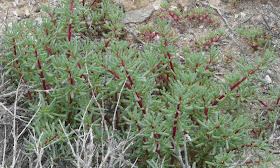
Here are some of the common plants that we would see in Spring Valley. Of course there is a lot of Sagebrush and Greasewood. Some Saltbrush and Winterfat. But the Spiny Hopsage (Grayia spinosa) sure was attractive this time of year with its red bracts.
 T
There is quite the diversity of Astragalus species out in the Great Basin. This one was fairly common and widely distributed throughout the area. It was fun to look at the different patterns on the pods. Some where all red, some green, and many in between.

One of the more common native grasses was Elymus elymoides, or Squirreltail. The scientific name always made me wonder. Of course it is an 'elymus-like elymus'.

This Eriogonum (ovalifolium) was one of the more common ones in the valley. It was very short, but the flowering heads were very showy. A rough count of Eriogonum species (Polygonaceae) in Nevada totals 82 species.


This was one of the highly-invasive species in the valley, Halogeton glomeratus or Saltlover. It thrived on disturbance, and would grow along two-tracks and in cattle-trampled areas, forming thick mats. Initially, careful attention had to be paid to tell this from fresh sprouts of Greasewood (Sarcobatus vermiculatus) and from young Tumbleweed (Salsola tragus). Halogeton has a spiny tip to the leaves.
There are many botanical names of the form "Elymus elymoides." These tautological names are the botanical equivalent of saying "reddish red." However, looking at the history of such names reveals the origin of such unusual names. Elymus elymoides was originally named Sitanion elymoides by Rafinesque. That is, the Sitanion that looks like an Elymus. When that species was transferred to the genus Elymus, the rules of botanical nomenclature dictate that the old species epithet remains unchanged (unless, of course, that species epithet is already in use for another species in the new genus). Thus, we end up with Elymus elymoides (the Elymus that looks like an Elymus).
ReplyDelete